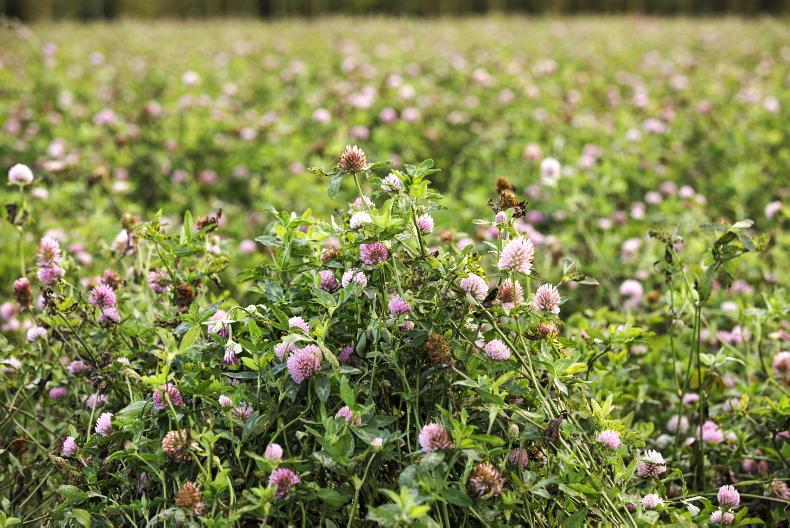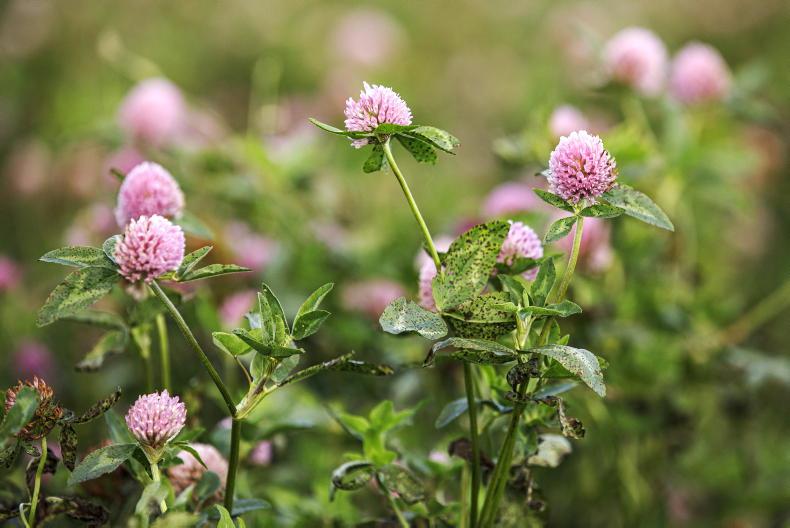Over the last 12 months, interest in red clover among Irish farmers has risen exponentially.
The fact that red clover swards can fix up to 300kg N/ha from the atmosphere is a certain attraction in a year like this when chemical nitrogen is not only very expensive but also in very short supply.
In January, Teagasc researcher James Humphreys presented a webinar on red clover and its potential role on Irish farms.

Red clover silage sward in flower. \ Donal O'Leary
Here are some of the key points from that presentation.
1 Red clover is susceptible to diseases such as stem eelworm, which is a nematode and sclerotinia trifolium, commonly known as clover rot. These diseases have affected red clover in the UK and Denmark, but have not been identified in Ireland yet. However, a four-year break in between red clover crops will help to prevent the disease from occurring.
2 White clover grows along the ground like ivy grows along a wall but red clover has a tap root and is more susceptible to damage from grazing animals. James says that red clover has very little ability for herbage reproduction – once it gets damaged it usually dies. For this reason, red clover is really only used for silage swards, but including some red clover in grazing swards is possible also.
3 In silage studies at Teagasc Grange over six years, red clover and perennial ryegrass swards receiving no chemical nitrogen grew slightly more silage on average than ryegrass-only swards getting 600kg N/ha.
4 When choosing red clover varieties, there is no Irish recommended list for red clover so the recommended lists from Northern Ireland and from England and Wales is the best place to get information. Only varieties that are on these lists should be sown in Ireland. See Table 1 for a list of varieties that perform well in Irish conditions.

Red clover can grow up to 1m high in the sward. \ Donal O'Leary
5 Red clover seed is far bigger than white clover seed, so typical seeding rates are 4kg of red clover per acre. Different seed mixtures are available depending on the strategy. If looking for a short-term ley for, say, three years you could sow 4kg/acre red clover along with 1kg/acre of white clover and 9kg/acre of a hybrid ryegrass. If looking for a permanent sward, James recommends 8kg/acre of perennial ryegrass seed, 4kg/acre of red clover seed and 1kg/acre of white clover seed.
After about four to five years, the percentage of red clover in the sward will die out but white clover should remain. James says the white clover can be topped up by oversowing if needs be.
The three or four years at the end of the 10-year reseeding cycle without red clover will help to prevent a buildup of disease. After 10 years, the field can then be reseeded again with red clover.
6 Red clover is not really suited to over-sowing and is best included as part of a full reseed.
7 Earlier silage harvesting in mid-May is better for yield and red clover persistency. Four-cut red clover silage systems at Grange between 2002 and 2007 yielded over 15t DM/ha with the first cut in late May and the final cut in late November. James says that the final cut needs to be managed carefully. If left uncut, it will rot over the winter.
8 Red clover silage is more difficult to ensile than just ryegrass and it will need a longer wilt time or an additive such as molasses.
At Teagasc Solohead, the red clover silage swards are cut and tedded and left to wilt for 48 hours before being raked and baled.
James says the third cut can be tricky to make because the weather can be more challenging and he says there is no hope of preserving the fourth cut in November, so this is typically zero grazed. Some farmers will graze the fourth cut with heifers, but he says other research work has shown that this shortens the life of the red clover.
9 The crude protein content of the silage harvested at Solohead in 2021 was low at 12.3%. Red clover silage is usually associated with higher crude protein levels.
10 Animal intake is much higher with red clover silage, which compensates for sometimes lower dry matter digestibility, so animal performance on red clover silage is usually excellent.
11 Where chemical nitrogen is applied to red clover silage, dry matter yield is usually lower as the red clover is suppressed by the chemical nitrogen.
12 Good soil fertility is essential for high yields. Nitrogen fixation is a biological process and pH needs to be at 6.5. There is very high take-off of potash in red clover silage. For crops yielding 15t DM/ha, there would be a requirement for 300 units/acre of K.
James says that outfarms are typically low in soil fertility and he recommends that where soils are at index one for P and K, there is 3kg/ha of P and 25kg/ha of K applied for every tonne/ha of dry matter yield expected at next harvest. This can be provided either by slurry or chemical fertiliser.
There is a risk of luxury uptake of K, which could lead to milk fever problems but under-fertilising for K results in a shorter red clover lifespan.
13 The conditions that are suitable for red clover are also suitable for docks and the best time to control docks is after reseeding. Clover should be past the shovel-shaped leaf before it is sprayed. It is expected that clover-safe sprays will be available under derogation again this season.
Over the last 12 months, interest in red clover among Irish farmers has risen exponentially.
The fact that red clover swards can fix up to 300kg N/ha from the atmosphere is a certain attraction in a year like this when chemical nitrogen is not only very expensive but also in very short supply.
In January, Teagasc researcher James Humphreys presented a webinar on red clover and its potential role on Irish farms.

Red clover silage sward in flower. \ Donal O'Leary
Here are some of the key points from that presentation.
1 Red clover is susceptible to diseases such as stem eelworm, which is a nematode and sclerotinia trifolium, commonly known as clover rot. These diseases have affected red clover in the UK and Denmark, but have not been identified in Ireland yet. However, a four-year break in between red clover crops will help to prevent the disease from occurring.
2 White clover grows along the ground like ivy grows along a wall but red clover has a tap root and is more susceptible to damage from grazing animals. James says that red clover has very little ability for herbage reproduction – once it gets damaged it usually dies. For this reason, red clover is really only used for silage swards, but including some red clover in grazing swards is possible also.
3 In silage studies at Teagasc Grange over six years, red clover and perennial ryegrass swards receiving no chemical nitrogen grew slightly more silage on average than ryegrass-only swards getting 600kg N/ha.
4 When choosing red clover varieties, there is no Irish recommended list for red clover so the recommended lists from Northern Ireland and from England and Wales is the best place to get information. Only varieties that are on these lists should be sown in Ireland. See Table 1 for a list of varieties that perform well in Irish conditions.

Red clover can grow up to 1m high in the sward. \ Donal O'Leary
5 Red clover seed is far bigger than white clover seed, so typical seeding rates are 4kg of red clover per acre. Different seed mixtures are available depending on the strategy. If looking for a short-term ley for, say, three years you could sow 4kg/acre red clover along with 1kg/acre of white clover and 9kg/acre of a hybrid ryegrass. If looking for a permanent sward, James recommends 8kg/acre of perennial ryegrass seed, 4kg/acre of red clover seed and 1kg/acre of white clover seed.
After about four to five years, the percentage of red clover in the sward will die out but white clover should remain. James says the white clover can be topped up by oversowing if needs be.
The three or four years at the end of the 10-year reseeding cycle without red clover will help to prevent a buildup of disease. After 10 years, the field can then be reseeded again with red clover.
6 Red clover is not really suited to over-sowing and is best included as part of a full reseed.
7 Earlier silage harvesting in mid-May is better for yield and red clover persistency. Four-cut red clover silage systems at Grange between 2002 and 2007 yielded over 15t DM/ha with the first cut in late May and the final cut in late November. James says that the final cut needs to be managed carefully. If left uncut, it will rot over the winter.
8 Red clover silage is more difficult to ensile than just ryegrass and it will need a longer wilt time or an additive such as molasses.
At Teagasc Solohead, the red clover silage swards are cut and tedded and left to wilt for 48 hours before being raked and baled.
James says the third cut can be tricky to make because the weather can be more challenging and he says there is no hope of preserving the fourth cut in November, so this is typically zero grazed. Some farmers will graze the fourth cut with heifers, but he says other research work has shown that this shortens the life of the red clover.
9 The crude protein content of the silage harvested at Solohead in 2021 was low at 12.3%. Red clover silage is usually associated with higher crude protein levels.
10 Animal intake is much higher with red clover silage, which compensates for sometimes lower dry matter digestibility, so animal performance on red clover silage is usually excellent.
11 Where chemical nitrogen is applied to red clover silage, dry matter yield is usually lower as the red clover is suppressed by the chemical nitrogen.
12 Good soil fertility is essential for high yields. Nitrogen fixation is a biological process and pH needs to be at 6.5. There is very high take-off of potash in red clover silage. For crops yielding 15t DM/ha, there would be a requirement for 300 units/acre of K.
James says that outfarms are typically low in soil fertility and he recommends that where soils are at index one for P and K, there is 3kg/ha of P and 25kg/ha of K applied for every tonne/ha of dry matter yield expected at next harvest. This can be provided either by slurry or chemical fertiliser.
There is a risk of luxury uptake of K, which could lead to milk fever problems but under-fertilising for K results in a shorter red clover lifespan.
13 The conditions that are suitable for red clover are also suitable for docks and the best time to control docks is after reseeding. Clover should be past the shovel-shaped leaf before it is sprayed. It is expected that clover-safe sprays will be available under derogation again this season.








 This is a subscriber-only article
This is a subscriber-only article











SHARING OPTIONS: